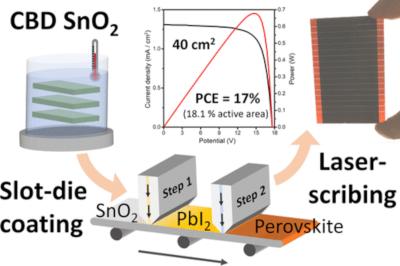Researchers from France's Institut Photovoltaïque d'Ãle-de-France (IPVF), EDF R&D and C2N have fabricated a mini perovskite solar module, via deposition of tin oxide as an electron extraction layer using chemical bath deposition (CBD), a low-cost and solution-based fabrication process.

Using this simple low-temperature deposition method, highly homogeneous SnO2 films can reportedly be made in a reproducible manner. In addition, the perovskite layer was prepared by sequentially slot-die coating on top of the n-type contact. The symbiosis of these two industrially relevant deposition techniques can allow for the growth of high-quality dense perovskite layers with large grains.
Perovskite solar cells fabricated from CBD SnO2 and slot-die-coated perovskite showed power conversion efficiencies up to 19.2%. Furthermore, mini-modules with an aperture area of 40 cm2 demonstrated efficiencies of 17% (18.1% on active area).
Through CBD, a large number of substrates can be coated in a single run with a proper chemical bath design. The scientists explained that: 'CBD has previously been employed at the industrial scale to produce cadmium sulfide (CdS) and zinc sulfide (ZnS) buffer layers in CIGS photovoltaic modules.'
The deposition process was performed for an hour and the temperature of the CBD reactor was maintained stable at 70 degrees Celsius. 'The desired SnO2 thickness was achieved by repeating the CBD deposition process multiple times. Finally, the substrates were rinsed with water and annealed at 180 degrees Celsius for one hour,' the research group stated.
The solar cell was fabricated with a glass-coated substrate made of fluorine-doped tin oxide (FTO), the SnO2 layer, a film made of a perovskite known as CsI/PbI that was deposited via slot-die coating, a spiro-OMeTAD hole-blocking layer, and a gold (Au) metal contact. 'This two-step deposition process, previously developed in our laboratory, allows the deposition of uniform and pinhole-free perovskite layers,' the scientists said. 'During the process, an intermediate layer containing CsI and PbI2 is deposited by a first slot-die coating step, then vacuum-treated to remove excess solvent and thereafter converted to perovskite [by] applying the organic cations solution on top using a second slot-die coating step.'